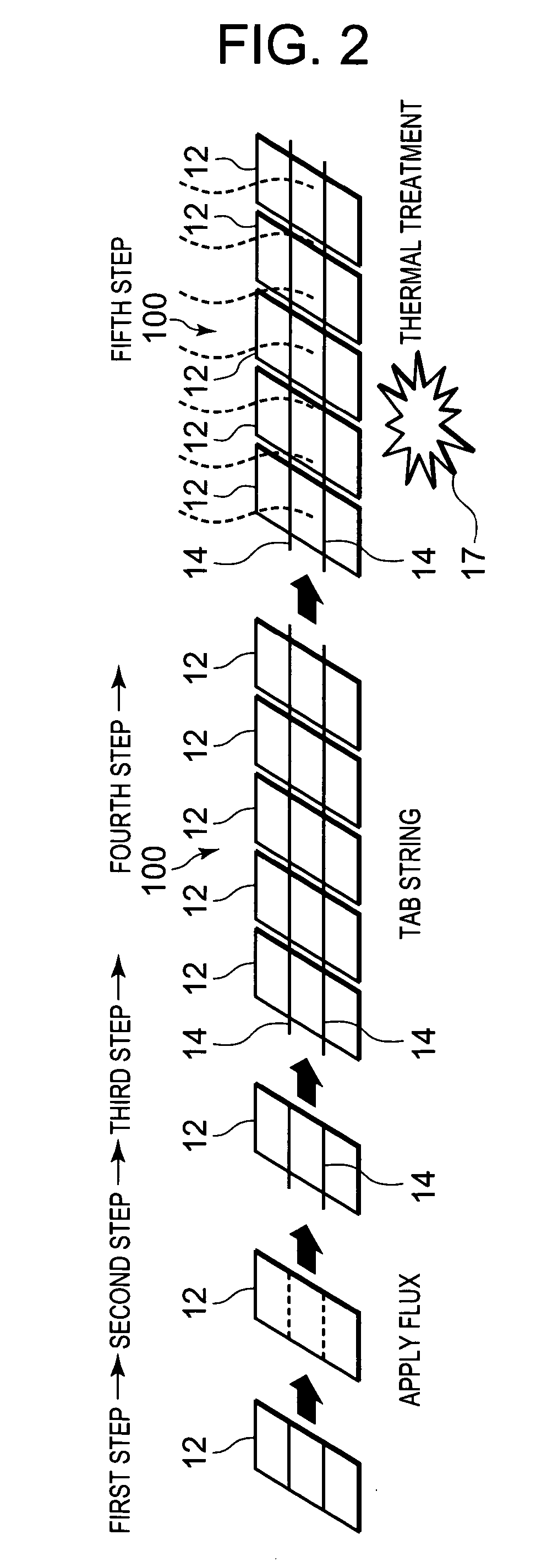Method of Manufacturing Solar Battery
- Summary
- Abstract
- Description
- Claims
- Application Information
AI Technical Summary
Benefits of technology
Problems solved by technology
Method used
Image
Examples
embodiment 1
[0041] Next, an embodiment of the present invention will be described in detail with reference to the drawings. FIG. 1 shows a manufacturing step diagram of a solar battery showing one embodiment of the present invention. It is to be noted that this embodiment shows a method of manufacturing a general solar battery. Since a technology to manufacture this solar battery is heretofore well known, detailed description thereof is omitted, and main points will be described.
[0042] First, in the present invention, each of cells 12 of the solar battery is formed into an about 10 by 10 cm square. Moreover, the cells 12 are arranged in one row in a longitudinal direction in a pallet (not shown), and detachably attached, and subsequent step operations are performed. In a method of manufacturing the solar battery, as shown in FIG. 1, the plurality of cells 12 using an n-type crystalline silicon substrate 10 constituted of a crystalline semiconductor such as polycrystal silicon is prepared, and ...
embodiment 2
[0053] Next, another embodiment of the present invention will be described in detail with reference to the drawings. FIG. 2 shows a manufacturing step diagram of a solar battery string 100 showing the present embodiment. It is to be noted that in FIG. 2, components denoted with the same reference numerals as those of FIG. 9 produce the same or similar functions. In the present embodiment, instead of a crystal type such as single crystal silicon or polycrystal silicon, an amorphous type such as amorphous silicon or a single crystal (crystalline substrate) type is used in the substrate. There are used single crystal or amorphous hybrid general cells 12 (solar battery cells) constituted by forming amorphous layers of silicon on opposite surfaces of the substrate. A method of manufacturing a solar battery constituted in this manner will be described. Since a technology to manufacture these cells 12 are heretofore well known, detailed description thereof is omitted, and main points will ...
embodiment 3
[0074] Next, still another embodiment of the present invention will be described. In the above embodiment, in the fifth step (cell heating step), the cells 12 are heated at +140° C. to +160° C. for one minute to five minutes, preferably at +150° C. for three minutes. In this case, in the present embodiment, in the fifth step (cell heating step), the heating temperature is set to be higher than +160° C., and the heating time is set to be less than one minute and remarkably short.
[0075] Preferably, the heating temperature is set to +200° C. or more, and the heating time is reduced to be less than 20 seconds. Thus, when the heating temperature of each cell 12 in the fifth step is set to be higher than +160° C., a flux of the cell 12 can be activated and evaporated for a remarkably short heating time which is less than one minute. Especially, when the heating temperature is set at +200° C. or more, the flux can be activated and evaporated for a remarkably short heating time which is le...
PUM
 Login to View More
Login to View More Abstract
Description
Claims
Application Information
 Login to View More
Login to View More - R&D
- Intellectual Property
- Life Sciences
- Materials
- Tech Scout
- Unparalleled Data Quality
- Higher Quality Content
- 60% Fewer Hallucinations
Browse by: Latest US Patents, China's latest patents, Technical Efficacy Thesaurus, Application Domain, Technology Topic, Popular Technical Reports.
© 2025 PatSnap. All rights reserved.Legal|Privacy policy|Modern Slavery Act Transparency Statement|Sitemap|About US| Contact US: help@patsnap.com



